Search Thermo Fisher Scientific
Page Contents
Polyacrylamide gel staining is a critical technique in the analysis of total proteins, as well as modified proteins such as phosphoproteins and glycoproteins.![]() The luminescent SYPRO protein gel stains are revolutionizing the detection of the total-protein profile in polyacrylamide gels. SYPRO protein gel stains exhibit several important characteristics that together make them far superior to traditional staining methods, including:
The luminescent SYPRO protein gel stains are revolutionizing the detection of the total-protein profile in polyacrylamide gels. SYPRO protein gel stains exhibit several important characteristics that together make them far superior to traditional staining methods, including:
- Fast and easy staining protocols
- High sensitivity
- Minimal protein-to-protein variation in staining
- Broad linear quantitation range
- Compatibility with subsequent microanalysis and a variety of instrumentation
Conventional methods for universal profiling of proteins in gels include Coomassie brilliant blue staining ![]() and silver staining.
and silver staining.![]() Although Coomassie brilliant blue is an inexpensive reagent, its staining is relatively insensitive and time consuming. Silver staining may be up to 100 times more sensitive than Coomassie brilliant blue staining, but it is relatively expensive and entails several labor-intensive and time-sensitive steps. Silver staining also exhibits a high degree of protein-to-protein variability; staining intensity and color are very dependent on each polypeptide's sequence and degree of glycosylation, and some proteins are detectable only as negatively stained patches. Moreover, silver staining shows very poor linearity with protein concentration (Figure 9.3.1) and poor reproducibility in staining from gel to gel, making it inadequate for comparative studies of protein expression in cells.
Although Coomassie brilliant blue is an inexpensive reagent, its staining is relatively insensitive and time consuming. Silver staining may be up to 100 times more sensitive than Coomassie brilliant blue staining, but it is relatively expensive and entails several labor-intensive and time-sensitive steps. Silver staining also exhibits a high degree of protein-to-protein variability; staining intensity and color are very dependent on each polypeptide's sequence and degree of glycosylation, and some proteins are detectable only as negatively stained patches. Moreover, silver staining shows very poor linearity with protein concentration (Figure 9.3.1) and poor reproducibility in staining from gel to gel, making it inadequate for comparative studies of protein expression in cells.
Many of the drawbacks of these traditional stains can be overcome by using one of the SYPRO protein gel stains, without sacrificing detection sensitivity.![]() We have developed a SYPRO dye optimized for protein profiling in nearly every type of gel (SYPRO and Coomassie Fluor luminescent and fluorescent protein gel stains—Table 9.2) or blot application (Molecular Probes fluorescent and luminescent protein blot stains—Table 9.3). The characteristics and applications of the individual SYPRO protein gel and blot stains for detecting the total-protein profile of a sample are described in this section. Detecting Protein Modifications—Section 9.4 discusses the use of these SYPRO stains in conjunction with phosphoprotein and glycoprotein detection reagents for multiparameter staining.
We have developed a SYPRO dye optimized for protein profiling in nearly every type of gel (SYPRO and Coomassie Fluor luminescent and fluorescent protein gel stains—Table 9.2) or blot application (Molecular Probes fluorescent and luminescent protein blot stains—Table 9.3). The characteristics and applications of the individual SYPRO protein gel and blot stains for detecting the total-protein profile of a sample are described in this section. Detecting Protein Modifications—Section 9.4 discusses the use of these SYPRO stains in conjunction with phosphoprotein and glycoprotein detection reagents for multiparameter staining.

Figure 9.3.1 Quantitation of proteins in gels using SYPRO Ruby protein gel stain versus silver stain. Dilutions of proteins were electrophoresed on eight different SDS-polyacrylamide gels, two gels for each of four dilution ranges. The gels were stained with either SYPRO Ruby protein gel stain (S12000, S12001, S21900) or a silver stain. Staining intensities were quantitated using either the Fluor-S MAX MultiImager documentation system (Bio-Rad Laboratories) or the FLA3000G laser scanner (Fuji Photo Film Co.) and plotted against the protein amount for bovine serum albumin. SYPRO Ruby protein gel stain shows a linear quantitation range over three orders of magnitude, as well as consistent staining intensities from gel to gel. In contrast, the silver stain shows linear quantitation over only a small range, a very shallow slope and inconsistent staining intensities from gel to gel, even when corrected for background differences.
SYPRO Ruby Protein Gel Stain: Ultrasensitive Protein Detection in 1D, 2D and IEF Gels
SYPRO Ruby protein gel stain (S12000, S12001, S21900) is a ready-to-use protein stain that has sensitivity equal to or exceeding that of the best silver staining techniques, is compatible with Edman sequencing and mass spectrometry ![]() and can be visualized with a simple UV transilluminator or a laser scanner.
and can be visualized with a simple UV transilluminator or a laser scanner.![]() SYPRO Ruby protein gel stain offers several advantages over conventional staining techniques:
SYPRO Ruby protein gel stain offers several advantages over conventional staining techniques:
- High-sensitivity staining. SYPRO Ruby protein gel stain provides at least the same subnanogram sensitivity as the best silver staining techniques in 1D, 2D
 or IEF gels (Figure 9.3.2).
or IEF gels (Figure 9.3.2). - Simple staining protocol. After fixation, the gel is incubated in the staining solution. No stop solutions or destaining steps are required and, unlike silver staining, gels can be left in the dye solution for indefinite periods without overstaining, vastly simplifying the simultaneous processing of multiple gels and making it possible to perform high-throughput staining without investing in robotic staining devices.
- Accurate peptide and protein detection. SYPRO Ruby protein gel stain shows little protein-to-protein variability in staining
 and detects some proteins that are completely missed by silver staining (Figure 9.3.3), such as heavily glycosylated proteins. Unlike silver staining, SYPRO Ruby dye does not stain extraneous nucleic acids, lipids or carbohydrates in the sample.
and detects some proteins that are completely missed by silver staining (Figure 9.3.3), such as heavily glycosylated proteins. Unlike silver staining, SYPRO Ruby dye does not stain extraneous nucleic acids, lipids or carbohydrates in the sample.
- Excellent performance in comparative protein expression studies. SYPRO Ruby stain shows a greater linear quantitation range than either silver or Coomassie brilliant blue staining—extending over three orders of magnitude—making it possible to accurately compare protein expression levels
 (Figure 9.3.1, Figure 9.3.2). Gel-to-gel staining is extremely consistent; same-spot intensity comparisons between identical 2D gels show a correlation coefficient of 0.9.
(Figure 9.3.1, Figure 9.3.2). Gel-to-gel staining is extremely consistent; same-spot intensity comparisons between identical 2D gels show a correlation coefficient of 0.9. Multiple gels can easily be compared using available software (
Multiple gels can easily be compared using available software ( ). Other protein quantitation methods, including running multiple prestained samples on the same gel, generally do not produce results that approach this level of discrimination.
). Other protein quantitation methods, including running multiple prestained samples on the same gel, generally do not produce results that approach this level of discrimination.
- Compatibility with microsequencing and mass spectrometry.
 Unlike silver staining techniques, which use glutaraldehyde- or formaldehyde-based fixatives, SYPRO Ruby dye is a gentle stain that interacts noncovalently with proteins. Thus, high-quality Edman sequencing or mass spectrometry data
Unlike silver staining techniques, which use glutaraldehyde- or formaldehyde-based fixatives, SYPRO Ruby dye is a gentle stain that interacts noncovalently with proteins. Thus, high-quality Edman sequencing or mass spectrometry data  (Figure 9.3.4) can be obtained immediately after staining, without modification steps that may compromise sensitivity. Automated in-gel digestion methods have been used in the analysis of femtomole levels of SYPRO Ruby dye–stained proteins.
(Figure 9.3.4) can be obtained immediately after staining, without modification steps that may compromise sensitivity. Automated in-gel digestion methods have been used in the analysis of femtomole levels of SYPRO Ruby dye–stained proteins.
- Utility for isoelectric focusing (IEF). SYPRO Ruby protein gel stain also provides a reliable, high-sensitivity staining method for isoelectric focusing (IEF) gels (Figure 9.3.5) without the problems typically encountered with silver staining, such as ampholyte staining or mirroring effects on the plastic gel backing.
- Minimal hazardous waste. As compared with silver stains, SYPRO Ruby protein gel stain generates much less hazardous waste, minimizing the time and expense associated with waste disposal.
SYPRO Ruby protein gel stain is based on an organometallic ruthenium complex that shows an extremely bright and photostable red-orange luminescence when excited with either UV or blue light (Figure 9.3.6). Stained proteins can be visualized using a UV transilluminator, a blue-light transilluminator or a laser-scanning instrument. Gels can then be documented using Polaroid 667 black-and-white print film, a CCD camera with an image documentation system or a laser-scanning instrument.![]() For optimal sensitivity using a UV transilluminator and Polaroid 667 black-and-white print film, the SYPRO photographic filter (S6656, see below) is recommended.
For optimal sensitivity using a UV transilluminator and Polaroid 667 black-and-white print film, the SYPRO photographic filter (S6656, see below) is recommended.
SYPRO Ruby protein gel stain is supplied as 200 mL of a 1X staining solution (S12001), sufficient for staining about four minigels, or 1 L of a 1X staining solution (S12000), sufficient for staining about 20 minigels or two standard 2D gels. Additionally, we offer SYPRO Ruby protein gel stain in a 5 L box (S21900), sufficient for staining about 100 minigels or 10 standard 2D gels. These boxes are easy to stack and store, and the convenient spigot makes it easy to dispense just the right amount of stain.
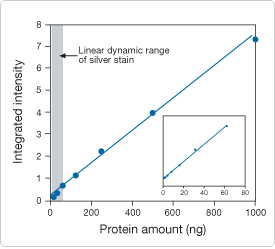
Figure 9.3.2 Amounts of carbonic anhydrase ranging from 1 ng to 1000 ng were separated on an SDS-polyacrylamide gel and stained with SYPRO Ruby protein gel stain (S12000, S12001, S21900). The inset shows the excellent linearity in the lower part of the range from 1 ng to 60 ng protein. Staining intensities were quantitated using the Molecular Imager FX documentation system (Bio-Rad Laboratories). For comparison, the gray band shows the linear range for the same protein detected with silver staining.
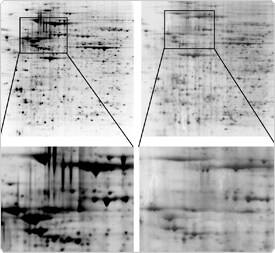
Figure 9.3.3 SYPRO Ruby protein gel stain (S12000, S12001, S21900) shows less protein-to-protein variation than silver staining. Proteins from a cell lysate were run on a 2D gel and stained with SYPRO Ruby protein gel stain (left) or silver stain (right). The grayscale values of the SYPRO Ruby dye–stained gel have been inverted for easier comparison with the silver-stained gel.
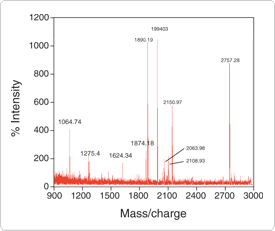
Figure 9.3.4 Mass spectrum profile of NADH:ubiquinone reductase precursor (75,000-dalton subunit) obtained after 2D gel electrophoresis of bovine heart mitochondria and staining with SYPRO Ruby protein gel stain (S12000, S12001, S21900). Bovine heart mitochondria were a gift of Roderick Capaldi, University of Oregon.
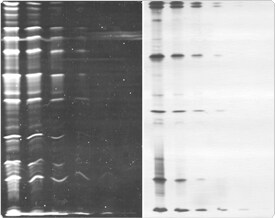
Figure 9.3.5 SYPRO Ruby protein gel stain versus silver stain for IEF gels. Serial dilutions of isoelectric focusing protein standards were electrophoresed on two identical polyacrylamide gels. One gel was stained with SYPRO Ruby protein gel stain (S12000, S12001, S21900) (left) and the other with silver stain (right). Both stains show a similar limit of sensitivity for all proteins.
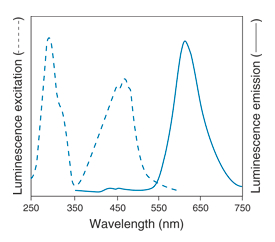
SYPRO Orange and SYPRO Red Protein Gel Stains: For Routine Detection of Proteins in 1D SDS-Polyacrylamide Gels
SYPRO Orange (S6650, S6651) and SYPRO Red (S6653, S6654) protein gel stains provide a fluorescence-based alternative for protein detection in SDS-polyacrylamide gels that is not only faster and more sensitive than Coomassie brilliant blue staining, but can be as sensitive as short-protocol silver staining methods (Figure 9.3.7) at a fraction of the time, effort and cost.![]()
In the presence of excess SDS, nonpolar regions of polypeptides are coated with detergent molecules, forming a micelle-like structure with a nearly constant SDS/protein ratio (1.4 g SDS:1.0 g protein); this constant charge-per-mass ratio is the basis of molecular weight determination by SDS-polyacrylamide gel electrophoresis. SYPRO Orange and SYPRO Red dyes bind to the SDS coat that surrounds proteins in SDS-polyacrylamide gels. Thus, the staining observed with these dyes exhibits relatively little protein-to-protein variation and is linearly related to protein mass (Figure 9.3.7). Some important features of SYPRO Orange and SYPRO Red protein gel stains include:
- Ease of use. Following electrophoresis, the gel is stained for 10–60 minutes and then briefly rinsed—no separate fixation, stop or destaining steps are required. After staining, the gel is immediately ready for photography, or it can be stored, in or out of the staining solution, for days.
- High sensitivity. SYPRO Orange and SYPRO Red protein gel stains routinely provide a sensitivity level of at least 8–16 ng per band in SDS-polyacrylamide minigels when visualized with standard 300 nm transillumination (Figure 9.3.7). Photography using Polaroid 667 black-and-white print film and a SYPRO photographic filter (S6656, see below) enhances the detection of staining with SYPRO Orange or SYPRO Red dye by several-fold over visible detection because the film integrates the signal throughout the duration of the exposure. Laser scanners also detect nanogram quantities of SYPRO dye–stained proteins in gels.
- Broad linear quantitation range. Protein detection in gels stained with either SYPRO Orange or SYPRO Red stain is linear over three orders of magnitude in protein quantity
 (Figure 9.3.8).
(Figure 9.3.8). - Uniform protein staining. Unlike silver staining,
 SYPRO Orange and SYPRO Red dyes exhibit relatively low protein-to-protein variability in SDS-polyacrylamide gels
SYPRO Orange and SYPRO Red dyes exhibit relatively low protein-to-protein variability in SDS-polyacrylamide gels  (Figure 9.3.8) and do not stain nucleic acids, which are sometimes found in protein mixtures from cell or tissue extracts.
(Figure 9.3.8) and do not stain nucleic acids, which are sometimes found in protein mixtures from cell or tissue extracts. In addition, SYPRO Orange and SYPRO Red dyes only weakly stain lipopolysaccharides in bacterial lysates, whereas these biopolymers are strongly detected by some types of silver staining.
In addition, SYPRO Orange and SYPRO Red dyes only weakly stain lipopolysaccharides in bacterial lysates, whereas these biopolymers are strongly detected by some types of silver staining. Glycoproteins (such as the IgG variable subunit) and proteins with prosthetic groups (such as bovine cytochrome oxidase) are also efficiently stained with SYPRO Orange and SYPRO Red dyes.
Glycoproteins (such as the IgG variable subunit) and proteins with prosthetic groups (such as bovine cytochrome oxidase) are also efficiently stained with SYPRO Orange and SYPRO Red dyes.
- Photostability. Proteins stained with SYPRO Orange or SYPRO Red dye are relatively photostable, enabling the researcher to acquire multiple photographic images and to use long film-exposure times (2–8 seconds). Gels that are illuminated for long periods of time may partially photobleach but can be restained with little loss of sensitivity.

- Compatibility with many types of instruments. Although their excitation maxima are in the visible range (Figure 9.3.9), SYPRO dye–stained gels are readily visualized using standard 300 nm transilluminators.
 SYPRO Orange protein gel stain also exhibits good sensitivity when viewed with a blue-light transilluminator, and both SYPRO Orange and SYPRO Red protein gel stains are suitable for use with many laser-scanning instruments.
SYPRO Orange protein gel stain also exhibits good sensitivity when viewed with a blue-light transilluminator, and both SYPRO Orange and SYPRO Red protein gel stains are suitable for use with many laser-scanning instruments.
- Chemical stability. SYPRO Orange and SYPRO Red gel stains are chemically stable; if protected from light, fluorescence of the stained gel is stable for several days, and staining solutions can be stored for months.
- Economy. SYPRO Orange and SYPRO Red gel stains are not only less expensive than silver-staining kits but faster and less laborious to use. Additionally, use of SYPRO Orange or SYPRO Red dye avoids the costs of purchase and disposal of large amounts of organic solvents that are required for Coomassie brilliant blue staining.
- Compatibility with mass spectroscopy. Unlike silver stains, SYPRO Orange and SYPRO Red dyes do not covalently bind to proteins, allowing subsequent analysis of stained proteins by microsequencing or mass spectrometry.

SYPRO Orange and SYPRO Red stains have very similar staining properties, although we have observed that proteins stained with SYPRO Orange dye are slightly brighter, whereas gels stained with SYPRO Red dye tend to have lower background fluorescence. For maximum sensitivity with UV transilluminators, we recommend documenting the signal using Polaroid 667 black-and-white print film and the SYPRO photographic filter (S6656, see below). For maximum sensitivity with laser scanners, we recommend matching the appropriate SYPRO dye with the excitation light source of the instrument. SYPRO Orange protein gel stain is most suitable for gel scanners that employ argon-ion lasers with output at 488 nm, whereas SYPRO Red protein gel stain is best matched to laser-scanning instruments that employ Nd:YAG lasers with output at 532 nm. SYPRO Red protein gel stain has been used as a prestain for protein analysis in an automated ultrathin-layer gel electrophoretic technique.![]() SYPRO Orange protein gel stain has been used for protein sizing on a microchip
SYPRO Orange protein gel stain has been used for protein sizing on a microchip ![]() and for analyzing the kinetics of isothermal protein denaturation
and for analyzing the kinetics of isothermal protein denaturation ![]() (Monitoring Protein-Folding Processes with Environment-Sensitive Dyes—Note 9.1).
(Monitoring Protein-Folding Processes with Environment-Sensitive Dyes—Note 9.1).
SYPRO Orange and SYPRO Red protein gel stains are compatible with SDS or urea/SDS gels. Staining native proteins in gels in the absence of SDS results in more protein-to-protein variation and lower sensitivity than staining SDS-denatured proteins, due to variations in hydrophobicity of the target polypeptides. However, sensitivity of SYPRO dye staining in native gels can be improved if gels are soaked in 0.05% SDS solution after electrophoresis but prior to staining. For optimal staining of proteins in 2D gels and IEF gels, we recommend SYPRO Ruby protein gel stain (S12000, S12001, S21900; see above).
Because SYPRO Orange and SYPRO Red dyes do not covalently bind to proteins, stained proteins can be subsequently analyzed by microsequencing or mass spectrometry.![]() These dyes, however, are not recommended for staining gels prior to blotting, as there is a significant loss of sensitivity when proteins are stained with SYPRO Orange or SYPRO Red dyes in typical western blotting buffers. To obtain maximum sensitivity when staining proteins in western blotting protocols, we recommend SYPRO Tangerine protein gel stain (S12010, see below) for staining proteins on the gel before blotting or SYPRO Ruby protein blot stain (S11791, see below) for staining proteins on nitrocellulose or PVDF membranes after blotting.
These dyes, however, are not recommended for staining gels prior to blotting, as there is a significant loss of sensitivity when proteins are stained with SYPRO Orange or SYPRO Red dyes in typical western blotting buffers. To obtain maximum sensitivity when staining proteins in western blotting protocols, we recommend SYPRO Tangerine protein gel stain (S12010, see below) for staining proteins on the gel before blotting or SYPRO Ruby protein blot stain (S11791, see below) for staining proteins on nitrocellulose or PVDF membranes after blotting.
SYPRO Orange and SYPRO Red protein gel stains are available as 500 µL stock solutions in dimethylsulfoxide (DMSO), either in a single vial (S6650, S6653) or specially packaged as a set of 10 vials, each containing 50 µL (S6651, S6654). The reagents are supplied as 5000X concentrates; thus, 500 µL of either stain yields 2.5 L of staining solution. Photography of proteins in gels, which is essential for obtaining the maximum sensitivity, requires use of the SYPRO photographic filter (S6656).

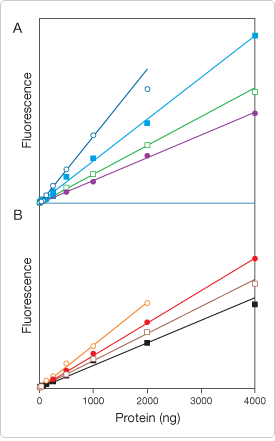
Figure 9.3.8 Quantitation of proteins in a gel using SYPRO Orange protein gel stain (S6650, S6651). A protein mixture was serially diluted and electrophoresed on a 15% SDS-polyacrylamide gel and then stained with SYPRO Orange protein gel stain. The gel was then scanned using a Molecular Dynamics Storm gel and blot analysis system (excitation/emission 488/>520 nm) and analyzed to yield the fluorescence intensities of the stained bands. The fluorescence intensity scale is the same in both panels, illustrating the minimal protein-to-protein staining variation of SYPRO Orange gel stain. Detection limits are between 2 and 16 ng of protein; the linear detection ranges are approximately 1000-fold. Proteins represented are: A) β-galactosidase (![]() ), lysozyme (
), lysozyme (![]() ), bovine serum albumin (BSA,
), bovine serum albumin (BSA, ![]() ) and phosphorylase B (
) and phosphorylase B (![]() ); B) myosin (
); B) myosin (![]() ), soybean trypsin inhibitor (
), soybean trypsin inhibitor (![]() ), ovalbumin (
), ovalbumin (![]() ) and carbonic anhydrase (
) and carbonic anhydrase (![]() ).
).
SYPRO Protein Gel Stain Starter Kit
SYPRO Orange, SYPRO Red and SYPRO Tangerine protein gel stains are all available in a SYPRO Protein Gel Stain Starter Kit (S12012) for first-time users. Each kit includes:
- 50 µL of SYPRO Orange protein gel stain, sufficient for 5–20 minigels
- 50 µL of SYPRO Red protein gel stain, sufficient for 5–20 minigels
- 50 µL of SYPRO Tangerine protein gel stain, sufficient for 5–20 minigels
- SYPRO protein gel stain photographic filter
- Detailed protocols (SYPRO Orange and SYPRO Red Protein Gel Stains, SYPRO Tangerine Protein Gel Stain)
Protein Molecular Weight Standards
We offer a protein mixture for use as molecular weight markers in SDS-polyacrylamide gel electrophoresis (Figure 9.3.12). This broad-range marker mixture (P6649) contains a balanced formulation of 11 polypeptides with molecular weights from 6500 to 205,000 daltons. These protein molecular weight standards give rise to sharp, well-separated bands when the gel is stained with any of our protein gel or blot stains. The mixture provides amounts of marker proteins sufficient for loading about 200 gel lanes. We also have available PeppermintStick phosphoprotein molecular weight standards (P33350) and CandyCane glycoprotein molecular weight standards (C21852), which are described in Detecting Protein Modifications—Section 9.4.
SYPRO Tangerine Protein Gel Stain: Sensitive Protein Detection without Fixation for Electroelution, Zymography and Classroom Use
SYPRO Tangerine protein gel stain ![]() (S12010), which stains proteins in gels without the need for either acids or organic solvents, serves as an alternative to conventional protein stains that fix proteins in the gel.
(S12010), which stains proteins in gels without the need for either acids or organic solvents, serves as an alternative to conventional protein stains that fix proteins in the gel.![]() Whereas SYPRO Orange and SYPRO Red stains require a staining solution containing acetic acid for maximum performance, staining with SYPRO Tangerine protein gel stain is possible in almost any buffer that contains NaCl. Because proteins are not fixed during the staining procedure, they can be readily eluted from gels, used for zymography (in-gel enzyme activity assays, Figure 9.3.10) or analyzed by mass spectrometry.
Whereas SYPRO Orange and SYPRO Red stains require a staining solution containing acetic acid for maximum performance, staining with SYPRO Tangerine protein gel stain is possible in almost any buffer that contains NaCl. Because proteins are not fixed during the staining procedure, they can be readily eluted from gels, used for zymography (in-gel enzyme activity assays, Figure 9.3.10) or analyzed by mass spectrometry.![]() SYPRO Tangerine stain can also be used to stain gels before transferring the proteins to nitrocellulose or PVDF membranes for immunostaining
SYPRO Tangerine stain can also be used to stain gels before transferring the proteins to nitrocellulose or PVDF membranes for immunostaining ![]() (western blotting). Like SYPRO Orange and SYPRO Red protein gel stains, SYPRO Tangerine protein gel stain shows high sensitivity (down to ~4 ng/band) and a broad linear quantitation range (Figure 9.3.11). SYPRO Tangerine protein gel stain is also ideal for use in educational settings, especially when used with UV-free blue-light transilluminators.
(western blotting). Like SYPRO Orange and SYPRO Red protein gel stains, SYPRO Tangerine protein gel stain shows high sensitivity (down to ~4 ng/band) and a broad linear quantitation range (Figure 9.3.11). SYPRO Tangerine protein gel stain is also ideal for use in educational settings, especially when used with UV-free blue-light transilluminators.
SYPRO Tangerine stain is compatible with conventional SDS-polyacrylamide gel electrophoresis, but it is not recommended for 2D or IEF gels. Stained proteins can be visualized using a UV transilluminator, a blue-light transilluminator or a laser scanner. Photography of stained gels using Polaroid 667 black-and-white print film requires use of the SYPRO photographic filter (S6656, see below) for optimal sensitivity. SYPRO Tangerine protein gel stain ![]() (S12010) is available as 500 µL of a 5000X concentrate in dimethylsulfoxide (DMSO), an amount sufficient to stain about 100 minigels.
(S12010) is available as 500 µL of a 5000X concentrate in dimethylsulfoxide (DMSO), an amount sufficient to stain about 100 minigels.

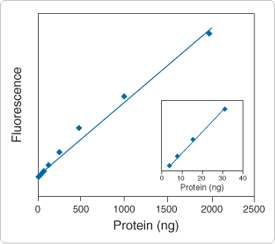
Figure 9.3.11 Linearity of SYPRO Tangerine protein gel stain (S12010). A dilution series of carbonic anhydrase was electrophoresed through a 13% SDS-polyacrylamide gel and stained with SYPRO Tangerine protein gel stain in 7% acetic acid. The fluorescence signal was quantified and plotted versus the protein amount, revealing a sensitivity limit of about 4 ng/band and a linear quantitation range over at least three orders of magnitude.
Electrophoretic Mobility-Shift (Bandshift) Assay (EMSA) Kit
To make bandshift assays easier, we offer the Electrophoretic Mobility-Shift Assay (EMSA) Kit (E33075), which provides a fast and quantitative fluorescence-based method for detecting both nucleic acid and protein in the same gel ![]() (
(![]() ). This kit uses two different stains for detection: the fluorescent SYBR Green EMSA nucleic acid gel stain for RNA or DNA and the luminescent SYPRO Ruby EMSA protein gel stain for proteins. Because the nucleic acids and proteins are stained in the gel after electrophoresis, there is no need to prelabel the DNA or RNA with a radioisotope, biotin or a fluorescent dye before the binding reaction, and therefore there is no possibility that the label will interfere with protein binding. Staining takes only about 20 minutes for the nucleic acid stain, and about 4 hours for the subsequent protein stain, yielding results much faster than radioisotope labeling (which may require multiple exposure times) or chemiluminescence-based detection (which requires blotting and multiple incubation steps).
). This kit uses two different stains for detection: the fluorescent SYBR Green EMSA nucleic acid gel stain for RNA or DNA and the luminescent SYPRO Ruby EMSA protein gel stain for proteins. Because the nucleic acids and proteins are stained in the gel after electrophoresis, there is no need to prelabel the DNA or RNA with a radioisotope, biotin or a fluorescent dye before the binding reaction, and therefore there is no possibility that the label will interfere with protein binding. Staining takes only about 20 minutes for the nucleic acid stain, and about 4 hours for the subsequent protein stain, yielding results much faster than radioisotope labeling (which may require multiple exposure times) or chemiluminescence-based detection (which requires blotting and multiple incubation steps).
This kit also makes it possible to perform ratiometric measurements of nucleic acid and protein in the same band, providing more detailed information on the binding interaction.![]() The signals from the two stains are linear over a broad range, allowing accurate determination of the amount of nucleic acid and protein, even in a single band, with detection limits of ~1 ng for nucleic acids and ~20 ng for protein. Both stains can be visualized using a standard 300 nm UV transilluminator, a 254 nm epi-illuminator or a laser scanner (
The signals from the two stains are linear over a broad range, allowing accurate determination of the amount of nucleic acid and protein, even in a single band, with detection limits of ~1 ng for nucleic acids and ~20 ng for protein. Both stains can be visualized using a standard 300 nm UV transilluminator, a 254 nm epi-illuminator or a laser scanner (![]() ). For optimal sensitivity using a UV transilluminator and Polaroid 667 black-and-white print film, the SYPRO photographic filter (S6656, see below) and the SYBR photographic filter (S7569, Nucleic Acid Detection on Gels, Blots and Arrays—Section 8.4) are recommended. Digital images can easily be overlaid for a two-color representation of nucleic acid and protein in the gel.
). For optimal sensitivity using a UV transilluminator and Polaroid 667 black-and-white print film, the SYPRO photographic filter (S6656, see below) and the SYBR photographic filter (S7569, Nucleic Acid Detection on Gels, Blots and Arrays—Section 8.4) are recommended. Digital images can easily be overlaid for a two-color representation of nucleic acid and protein in the gel.
The EMSA Kit contains sufficient reagents for 10 nondenaturing polyacrylamide minigel assays, including:
- SYBR Green EMSA nucleic acid gel stain
- SYPRO Ruby EMSA protein gel stain
- Trichloroacetic acid, for preparing the working solution of SYPRO Ruby EMSA protein gel stain
- Concentrated EMSA gel-loading solution
- Concentrated binding buffer
- Detailed protocols (Electrophoretic Mobility Shift Assay (EMSA) Kit)
SYPRO Photographic Filter
To achieve optimal sensitivity with the SYPRO stains, it is essential to photograph the gel or blot because the camera's integrating capability can make bands visible that are not detected by eye. Photographs should be taken using a photographic filter with spectral properties closely matched to those of the fluorescent or luminescent dye used.
When using Polaroid 667 black-and-white print film and UV illumination, protein gels or blots stained with any of the SYPRO protein stains (including SYPRO Ruby, SYPRO Orange, SYPRO Red and SYPRO Tangerine gel stains as well as SYPRO Ruby protein blot stain) should be photographed through the SYPRO photographic filter (S6656, Figure 9.3.13, Figure 9.3.14), a 75 mm × 75 mm gelatin filter. Note that these gelatin filters are generally not suitable for use with portable or stationary gel-documentation systems or with CCD cameras.

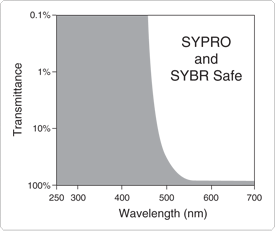
Coomassie Fluor Orange protein gel stain (C33250, C33251) provides a fast, simple and sensitive method for staining proteins in SDS-polyacrylamide electrophoretic gels. Gels do not need to be washed before staining with the Coomassie Fluor Orange dye or destained after staining. After electrophoresis, the gel is simply stained, rinsed and photographed on a standard UV transilluminator. Our premixed and ready-to-use Coomassie Fluor Orange protein gel stain offers the following advantages over conventional colorimetric stains:
- High sensitivity. Coomassie Fluor Orange protein gel stain detects as little as 8 ng of protein per minigel band (
). This sensitivity matches the best colloidal Coomassie stains and exceeds standard Coomassie brilliant blue stains.
- Broad linear range of detection. The fluorescence intensity of Coomassie Fluor Orange dye–stained bands is linear with protein quantity over at least two orders of magnitude, permitting accurate quantitation.
- Rapid staining. Staining is complete in less than an hour, and there is no risk of overstaining the gel.
- Compatibility with standard laboratory equipment. Stained proteins can be visualized using a standard 300 nm UV transilluminator or a laser scanner (Figure 9.3.15). For optimal sensitivity using a UV transilluminator and Polaroid 667 black-and-white print film, the SYPRO photographic filter (S6656, see above) is recommended.
- Low protein-to-protein variability. Because Coomassie Fluor Orange dye interacts with the SDS coat around proteins in the gel, it gives more consistent staining between different types of proteins, as compared with Coomassie brilliant blue staining, and it never exhibits negative staining. Coomassie Fluor Orange dye also stains glycoproteins.
- High selectivity for proteins. Coomassie Fluor Orange protein gel stain detects a variety of proteins down to ~6500 daltons without staining nucleic acid or lipopolysaccharide contaminants that are sometimes found in protein preparations derived from cell or tissue extracts.
Coomassie Fluor Orange protein gel stain is not recommended for staining proteins in 2D, IEF or nondenaturing gels; for these applications we recommend our SYPRO Ruby protein gel stain (S12000, S12001, S21900; see above).
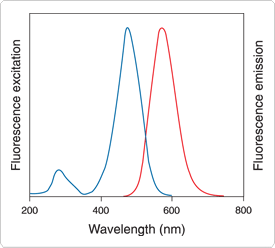
Rhinohide polyacrylamide gel strengthener improves upon classic polyacrylamide gel technology by making gels much stronger, providing easier handling and much greater resistance to tearing without adverse side effects (Figure 9.3.16). Rhinohide polyacrylamide gel strengthener is highly recommended for low-percentage gels, large-format gels and gels subject to multiple staining and handling steps, and it is compatible with fluorescent protein stains as well as silver and Coomassie stains.
SDS-polyacrylamide gels supplemented with Rhinohide polyacrylamide gel strengthener exhibit resolution capabilities comparable to traditional SDS-polyacrylamide gels, with clear, focused bands and without the undesirable side effects common with other gel strengtheners. For example, film-backed gels and polyester fabric–reinforced gels interfere with blotting techniques and can negatively affect protein staining. Alternatively, strengthening gels by the addition of pre-formed polymers causes turbidity and can produce serious spot-morphology artifacts, such as the distortion of high molecular weight bands or doubling of protein spots in the molecular weight dimension of 2D gels.![]() Rhinohide polyacrylamide gel strengthener produces gels with excellent transparency, providing exceptional image viewing and scanning of fluorescently stained gels with minimal background staining. We offer a concentrated form of the Rhinohide polyacrylamide gel strengthener (R33400) for adding to existing stock solutions of acrylamide/bis-acrylamide (37.5:1). Because prestained proteins, such as prestained molecular weight markers, will not migrate correctly in acrylamide gels containing the Rhinohide polyacrylamide gel strengthener, we recommend using only unstained proteins as markers.
Rhinohide polyacrylamide gel strengthener produces gels with excellent transparency, providing exceptional image viewing and scanning of fluorescently stained gels with minimal background staining. We offer a concentrated form of the Rhinohide polyacrylamide gel strengthener (R33400) for adding to existing stock solutions of acrylamide/bis-acrylamide (37.5:1). Because prestained proteins, such as prestained molecular weight markers, will not migrate correctly in acrylamide gels containing the Rhinohide polyacrylamide gel strengthener, we recommend using only unstained proteins as markers.
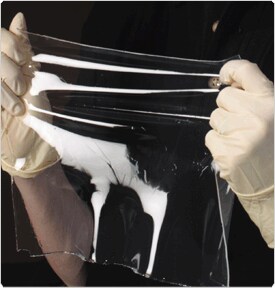
Figure 9.3.16 Demonstration of the strength and durability of gels made with the Rhinohide polyacrylamide gel strengthener (R33400).
To characterize specific proteins in complex mixtures, proteins are frequently separated by electrophoresis, then blotted onto nitrocellulose or PVDF (poly(vinylidene difluoride)) membranes (blots) for immunostaining ![]() (western blotting), glycoprotein staining, sequencing or mass spectrometry. Total-protein stains provide valuable information about the protein samples on blots, making it possible to assess the efficiency of protein transfer to the blot, detect contaminating proteins in the sample and compare the sample with molecular weight standards. For blots of 2D gels, staining of the entire protein profile makes it easier to localize a protein to a particular spot in the complex protein pattern. The superior properties of our fluorescent and luminescent protein stains, compared with conventional colorimetric stains, make it possible to quickly and easily obtain this information without running duplicate gels. Our luminescent and fluorescent protein staining technology can also be combined with fluorescent reagents for phosphoprotein and glycoprotein detection, which are described in detail in Detecting Protein Modifications—Section 9.4, to create multiparameter staining for multiplex analyses.
(western blotting), glycoprotein staining, sequencing or mass spectrometry. Total-protein stains provide valuable information about the protein samples on blots, making it possible to assess the efficiency of protein transfer to the blot, detect contaminating proteins in the sample and compare the sample with molecular weight standards. For blots of 2D gels, staining of the entire protein profile makes it easier to localize a protein to a particular spot in the complex protein pattern. The superior properties of our fluorescent and luminescent protein stains, compared with conventional colorimetric stains, make it possible to quickly and easily obtain this information without running duplicate gels. Our luminescent and fluorescent protein staining technology can also be combined with fluorescent reagents for phosphoprotein and glycoprotein detection, which are described in detail in Detecting Protein Modifications—Section 9.4, to create multiparameter staining for multiplex analyses.
SYPRO Ruby protein blot stain ![]() (Molecular Probes fluorescent and luminescent protein blot stains—Table 9.3) provides fast and highly sensitive detection of proteins blotted onto membranes, making it easy to assess the efficiency of protein transfer to the blot and to determine if lanes are loaded equally
(Molecular Probes fluorescent and luminescent protein blot stains—Table 9.3) provides fast and highly sensitive detection of proteins blotted onto membranes, making it easy to assess the efficiency of protein transfer to the blot and to determine if lanes are loaded equally ![]() (Figure 9.3.17). Because the stain does not covalently alter the proteins, it can be used to locate proteins on blots before sequencing or mass spectrometry.
(Figure 9.3.17). Because the stain does not covalently alter the proteins, it can be used to locate proteins on blots before sequencing or mass spectrometry.![]() It can also be used before chromogenic, fluorogenic or chemiluminescent immunostaining procedures to locate molecular weight markers and visualize the total-protein profile in the sample.
It can also be used before chromogenic, fluorogenic or chemiluminescent immunostaining procedures to locate molecular weight markers and visualize the total-protein profile in the sample.![]() Furthermore, the stain does not interfere with subsequent identification techniques, eliminating the need to run duplicate gels, vastly simplifying the comparison of total protein and target protein on western blots, and allowing precise localization of the target protein relative to other proteins on electroblots of 2D gels. SYPRO Ruby protein blot stain is also compatible with our Pro-Q Emerald glycoprotein blot stains for glycoproteins
Furthermore, the stain does not interfere with subsequent identification techniques, eliminating the need to run duplicate gels, vastly simplifying the comparison of total protein and target protein on western blots, and allowing precise localization of the target protein relative to other proteins on electroblots of 2D gels. SYPRO Ruby protein blot stain is also compatible with our Pro-Q Emerald glycoprotein blot stains for glycoproteins ![]() (Detecting Protein Modifications—Section 9.4). The superior properties of SYPRO Ruby protein blot stain, as compared with conventional protein blot stains, make it possible to routinely stain blots for total protein before continuing with specific protein detection techniques. SYPRO Ruby protein blot stain
(Detecting Protein Modifications—Section 9.4). The superior properties of SYPRO Ruby protein blot stain, as compared with conventional protein blot stains, make it possible to routinely stain blots for total protein before continuing with specific protein detection techniques. SYPRO Ruby protein blot stain ![]() (S11791) combines the following superior staining characteristics:
(S11791) combines the following superior staining characteristics:
- High sensitivity. SYPRO Ruby protein blot stain can detect as little as 0.25–1 ng protein/mm2 (~2–8 ng/band) blotted onto PVDF or nitrocellulose membranes after only 15 minutes of staining
(Figure 9.3.17). This sensitivity on blots is far better than that of colorimetric stains, such as Ponceau S, amido black or Coomassie brilliant blue, and rivals the best colloidal gold blot-staining techniques (Figure 9.3.18).
- Rapid total-protein staining procedure. The SYPRO Ruby protein blot-staining protocol takes less than an hour—including fixation and wash steps—and maximum sensitivity is achieved after only 15 minutes of dye staining, even for some peptides as small as seven amino acids. In contrast, gold or silver staining procedures may require overnight incubations to achieve maximum sensitivity and usually include extensive wash procedures that must be carefully timed.
- Compatibility with western blot protocols. Staining the total-protein profile on the blot eliminates guesswork about transfer efficiency and removes the need to run two gels for comparison of total and target protein.
SYPRO Ruby protein blot stain is gentle and, unlike colorimetric or colloidal gold blot stains, does not interfere with subsequent colorimetric or chemiluminescent immunodetection of proteins on western blots.
- Compatibility with standard microsequencing and mass spectrometry protocols. Whereas colloidal gold, Coomassie brilliant blue and amido black staining can interfere with post-staining analysis,
SYPRO Ruby protein blot stain binds noncovalently to proteins and is thus fully compatible with Edman sequencing or mass spectrometry.
SYPRO Ruby protein blot stain is based on an organometallic ruthenium complex. Because the ruthenium complex has dual-excitation maxima (Figure 9.3.6), the dye exhibits luminescence upon excitation with either UV or visible light. This property makes it possible to visualize the luminescence with many types of instruments, including UV epi-illumination sources, UV or blue-light transilluminators and a variety of laser-scanning instruments, including those with excitation light at 450 nm, 473 nm, 488 nm or 532 nm. Also, SYPRO Ruby dye–stained proteins can be indirectly excited by the chemiluminescence of the high-energy intermediate produced in the reaction of bis-(2,4,6-trichlorophenyl) oxalate (TCPO) with H2O2.![]() The red luminescence of the ruthenium complex has a peak at ~618 nm that is well separated from these excitation peaks, minimizing the amount of background signal seen from the excitation source. The staining signal can be documented using Polaroid 667 black-and-white print film and a SYPRO photographic filter (S6656, see above), using a CCD-based imaging system equipped with a 600 nm bandpass or 490 nm longpass filter, or by using the appropriate filter set and software in a laser scanner. SYPRO Ruby protein blot stain has exceptional photostability, allowing long exposure times for maximum sensitivity.
The red luminescence of the ruthenium complex has a peak at ~618 nm that is well separated from these excitation peaks, minimizing the amount of background signal seen from the excitation source. The staining signal can be documented using Polaroid 667 black-and-white print film and a SYPRO photographic filter (S6656, see above), using a CCD-based imaging system equipped with a 600 nm bandpass or 490 nm longpass filter, or by using the appropriate filter set and software in a laser scanner. SYPRO Ruby protein blot stain has exceptional photostability, allowing long exposure times for maximum sensitivity.
SYPRO Ruby protein blot stain (S11791) is supplied as a 1X staining solution, which is sufficient for staining ~1600 cm2 of blotting membrane, and is accompanied by a detailed protocol for its use.
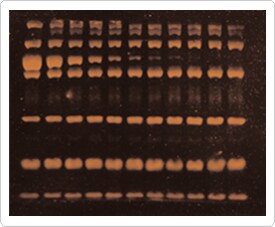
Figure 9.3.17 Protein detection with SYPRO Ruby protein blot stain (S11791). Samples of protein molecular weight standards containing a twofold dilution series of α-tubulin, starting with 1 µg of tubulin in the left-most lane, were run on an SDS-polyacrylamide gel, blotted onto a PVDF membrane and stained with SYPRO Ruby protein blot stain.

Figure 9.3.18 Comparison of commonly used stains for proteins on blots. Twofold serial dilutions of protein molecular weight standards ranging from 2000 to 1 ng/band were run on six identical SDS-polyacrylamide gels and blotted to PVDF membrane. The membranes were then stained with A) Ponceau S stain, B) Coomassie brilliant blue stain, C) colloidal silver stain, D) amido black stain, E) colloidal gold stain or F) SYPRO Ruby protein blot stain (S11791).
SYPRO Dyes for Reversible Protein Detection on Microarrays
We have found that SYPRO protein blot stains perform particularly well when staining proteins on PVDF microarrays for quality control and normalization purposes.![]() SYPRO Ruby protein blot stain (S11791) shows good sensitivity on protein microarrays (
SYPRO Ruby protein blot stain (S11791) shows good sensitivity on protein microarrays (![]() ) and should be very useful for staining proteins before exposing the microarray to the sample. The stain washes off PVDF membranes very easily under conditions used with typical western blot blocking buffers.
) and should be very useful for staining proteins before exposing the microarray to the sample. The stain washes off PVDF membranes very easily under conditions used with typical western blot blocking buffers.
Reactive Fluorescent Dyes for Permanent Protein Detection on Microarrays
The BODIPY reactive dyes described in BODIPY Dye Series—Section 1.4 label amine groups (predominantly lysine residues) on proteins. As compared to the reversible SYPRO blot stains described above, the amine-reactive BODIPY FL-X succinimidyl ester (D6102) shows even greater sensitivity for microarray staining (![]() ), making it useful for quality control testing or as an internal normalization standard. Both BODIPY FL-X succinimidyl ester and and the red-fluorescent BODIPY TR-X succinimidyl ester (D6116) are particularly effective general stains for proteins on PVDF membranes
), making it useful for quality control testing or as an internal normalization standard. Both BODIPY FL-X succinimidyl ester and and the red-fluorescent BODIPY TR-X succinimidyl ester (D6116) are particularly effective general stains for proteins on PVDF membranes ![]() (Molecular Probes fluorescent and luminescent protein blot stains—Table 9.3).
(Molecular Probes fluorescent and luminescent protein blot stains—Table 9.3).
This unique method of staining total protein on blots with the reactive BODIPY dyes has an approximately 30-fold linear dynamic range (Figure 9.3.19), although the absolute intensity between proteins may vary somewhat with the nature of the protein. Reactive BODIPY dye–based staining is rapid, simple and highly sensitive, permitting detection of as little as 4 ng of a protein per band in about an hour. Because the reactive dyes form a covalent bond with the protein, the staining is permanent and lasts through any subsequent blot manipulations. The covalent modification appears to minimally interfere with subsequent immunostaining, as we have successfully performed two-color labeling with reactive BODIPY dyes and either fluorogenic immunostains or glycoprotein stains and visualized both stains simultaneously (Figure 9.3.20). Simultaneous dual labeling of a sample simplifies localization of a specific protein with respect to other proteins in the sample, particularly on electroblots of 2D gels, pairs of which are difficult to align. Note that because reaction of the dye covalently modifies the protein at random locations, staining by the amine-reactive BODIPY dyes may complicate or preclude subsequent analysis by mass spectrometry or microsequencing.
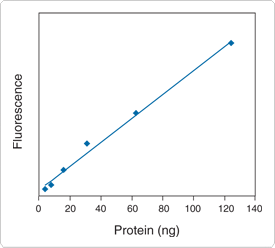
Figure 9.3.19 Linear dynamic range of detection for BODIPY FL-X succinimidyl ester, used as a blot stain. A twofold dilution series of molecular weight markers (P6649) was loaded onto a gel, electrophoresed and electroblotted to a PVDF membrane. The proteins on the blot were then stained with BODIPY FL-X succinimidyl ester (D6102). The fluorescence intensity for one of the proteins (carbonic anhydrase) was measured and plotted against the amount of protein loaded in the lane. The result shows an approximately linear dynamic range from 4 ng to 125 ng.

Capillary electrophoresis (CE) is an exceptionally powerful tool for the resolution of biomolecules.![]() Fluorescent detection of proteins that are separated by capillary electrophoresis can occur either during the run—the more common procedure—or subsequent to the separation on isolated fractions. When detected during the electrophoretic separation, the protein is either derivatized with a fluorescent reagent prior to the separation or labeled with a fluorescent dye that is incorporated into the running medium. In general, the same reagents may be useful for fluorometric detection of peptides and proteins that are separated by high-performance liquid chromatography (HPLC). In addition to the total-protein staining techniques described below, many selective staining techniques, such as the use of BODIPY FL GTP-γ-S (G22183, Probes for Protein Kinases, Protein Phosphatases and Nucleotide-Binding Proteins—Section 17.3) to detect GTP-binding proteins,
Fluorescent detection of proteins that are separated by capillary electrophoresis can occur either during the run—the more common procedure—or subsequent to the separation on isolated fractions. When detected during the electrophoretic separation, the protein is either derivatized with a fluorescent reagent prior to the separation or labeled with a fluorescent dye that is incorporated into the running medium. In general, the same reagents may be useful for fluorometric detection of peptides and proteins that are separated by high-performance liquid chromatography (HPLC). In addition to the total-protein staining techniques described below, many selective staining techniques, such as the use of BODIPY FL GTP-γ-S (G22183, Probes for Protein Kinases, Protein Phosphatases and Nucleotide-Binding Proteins—Section 17.3) to detect GTP-binding proteins,![]() can be applied to proteins separated by capillary electrophoresis.
can be applied to proteins separated by capillary electrophoresis.
Use of SYPRO Dyes for Capillary Electrophoresis
SDS–capillary gel electrophoresis (SDS-CGE) separates proteins based on principles similar to those of standard slab-gel electrophoresis, but with the advantages of faster run times, higher resolution and greater sensitivity. The use of online detection by laser-induced fluorescence (LIF) increases the sensitivity several orders of magnitude over UV detection, eliminates the time spent staining and photographing the gel and allows for the possibility of automated sample processing. SDS-CGE analyzed by LIF is widely used for the separation and identification of DNA fragments and has increased the efficiency of genomics, DNA typing and forensics laboratories.![]() SDS-CGE promises to be just as useful for proteomics laboratories and other laboratories that require characterization of a large number of protein samples.
SDS-CGE promises to be just as useful for proteomics laboratories and other laboratories that require characterization of a large number of protein samples.
For SDS-CGE of protein samples, the amine groups of lysine residues and the N-terminus of the proteins are typically derivatized with a fluorescent or fluorogenic dye such as the ATTO-TAG CBQCA ![]() (A2333, A6222) or ATTO-TAG FQ
(A2333, A6222) or ATTO-TAG FQ ![]() (A2334, A10192) reagents before separation in the capillary. The derivatized proteins are then coated with SDS and travel through the capillary gel towards the positive electrode based on their size, with smaller proteins traveling faster. The derivatized proteins are detected by fluorescence emitted as they pass a laser that excites the fluorophores.
(A2334, A10192) reagents before separation in the capillary. The derivatized proteins are then coated with SDS and travel through the capillary gel towards the positive electrode based on their size, with smaller proteins traveling faster. The derivatized proteins are detected by fluorescence emitted as they pass a laser that excites the fluorophores.
One disadvantage of this labeling technique is that the proteins generally contain multiple amine groups, each of which can react with the derivatization reagent. Typically, only a few of the amine groups on each protein molecule react, and the result is an enormous number of different derivatives, creating broad peaks that may be difficult to correlate with the original protein's structure or abundance.![]() In addition, variations between runs make it difficult to reproducibly estimate molecular weights. In contrast, use of SYPRO Red protein gel stain (S6653, S6654) to prestain SDS-coated proteins allows more accurate determination of molecular weights because the proteins are relatively uniformly coated with SDS and the dye. Staining the SDS-coated proteins with SYPRO Red protein gel stain leads to molecular weight determinations similar in accuracy to those achieved with polyacrylamide slab gels, with a limit of detection estimated to exceed the detection limit of silver staining in slab gels.
In addition, variations between runs make it difficult to reproducibly estimate molecular weights. In contrast, use of SYPRO Red protein gel stain (S6653, S6654) to prestain SDS-coated proteins allows more accurate determination of molecular weights because the proteins are relatively uniformly coated with SDS and the dye. Staining the SDS-coated proteins with SYPRO Red protein gel stain leads to molecular weight determinations similar in accuracy to those achieved with polyacrylamide slab gels, with a limit of detection estimated to exceed the detection limit of silver staining in slab gels.![]() The NanoOrange reagent (N6666, Protein Quantitation in Solution—Section 9.2) is also reported to be an effective reagent for detecting proteins that have been separated by microchip capillary electrophoresis.
The NanoOrange reagent (N6666, Protein Quantitation in Solution—Section 9.2) is also reported to be an effective reagent for detecting proteins that have been separated by microchip capillary electrophoresis.![]()
Protein Derivatization Reagents
Several of the same reagents that were described in Protein Quantitation in Solution—Section 9.2 for protein quantitation in solution are also useful for peptide and protein derivatization, either prior to or following separation by capillary electrophoresis. However, chemical derivatization prior to separation is likely to change the electronic charge and always changes the mass of the protein. Furthermore, incomplete derivatization of amines or thiols on the protein can lead to a pure protein resolving into multiple species in the electrophoretogram.
In an improved procedure for fluorescent analysis of peptides by capillary electrophoresis, Zhou and colleagues ![]() modified all α- and ε-amino groups of the peptide with phenyl isothiocyanate. Following one cycle of Edman degradation, the single free α-amino group was modified with fluorescent reagents to give a homogeneous, dye-labeled peptide.
modified all α- and ε-amino groups of the peptide with phenyl isothiocyanate. Following one cycle of Edman degradation, the single free α-amino group was modified with fluorescent reagents to give a homogeneous, dye-labeled peptide.
The preferred reagents for derivatizing amine residues in proteins either prior to or following electrophoretic separation are those that are essentially nonfluorescent until reacted with the protein. These include:
- ATTO-TAG CBQCA, which is available in the ATTO-TAG CBQCA Amine-Derivatization Kit (A2333) and as a stand-alone reagent (A6222). ATTO-TAG CBQCA reacts with primary amines to form highly fluorescent isoindoles
and has been extensively used for the derivatization of amino acids,
peptides
and carbohydrates
prior to capillary electrophoretic separation. ATTO-TAG CBQCA has been used to derivatize a fusion protein expressed in the bacterium Escherichia coli before purification by capillary zone electrophoresis. After purification, the fluorescent isoindole can be removed by acid treatment to allow sequencing of the purified protein.
- ATTO-TAG FQ (3-(2-furoyl)quinoline-2-carboxaldehyde), which is available in our ATTO-TAG FQ Amine-Derivatization Kit (A2334) and as a stand-alone reagent (A10192). ATTO-TAG FQ has been used as a protein detection reagent in capillary electrophoresis.
It has been reported that ATTO-TAG FQ can detect as little as 200 attomoles of a protein by capillary electrophoresis.
Excitation of amine derivatives of ATTO-TAG FQ by the 488 nm spectral line of the argon-ion laser is more efficient than that of ATTO-TAG CBQCA derivatives. A report
describes the solid-phase derivatization of dilute peptide solutions (10-8 M) that have been immobilized on Immobilon CD membranes. This technique permits the quantitative derivatization and analysis by capillary electrophoresis of only a few picomoles of the analyte.
- Fluorescamine (F2332, F20261), a nonfluorescent reagent that rapidly reacts with amines to give a fluorescent product. Fluorescamine has been used for solution quantitation of proteins and peptides (Protein Quantitation in Solution—Section 9.2). It is also useful as a peptide and protein detection reagent for capillary electrophoresis.
Use of fluorescamine to derivatize a standard protein of known molecular weight together with use of the ATTO-TAG FQ reagent to derivatize the sample protein allows the sample to be run simultaneously with the standard, improving the accuracy of molecular weight determination.
Chiral separation of fluorescamine-labeled amino acids has been optimized using capillary electrophoresis in the presence of hydroxypropyl-β-cyclodextran, a method designed for use in extraterrestrial exploration on Mars.
- Dialdehydes OPA and NDA (P2331MP, N1138), which react with amines in the presence of a nucleophile to give fluorescent products. These inexpensive reagents have been used for capillary electrophoresis of peptides and proteins.
Fluorophores and Their Amine-Reactive Derivatives—Chapter 1 describes a variety of other amine-reactive reagents that have been used or may be useful for peptide and protein detection in capillary electrophoresis, including dansyl chloride ![]() (D21), NBD chloride (C20260), NBD fluoride (F486), FITC
(D21), NBD chloride (C20260), NBD fluoride (F486), FITC ![]() (F143), Pacific Blue succinimidyl ester
(F143), Pacific Blue succinimidyl ester ![]() (P10163) and other common reagents described in Reagents for Analysis of Low Molecular Weight Amines—Section 1.8.
(P10163) and other common reagents described in Reagents for Analysis of Low Molecular Weight Amines—Section 1.8.
Derivatization reagents that react with thiols or other functional groups have also been used for protein detection in capillary electrophoresis. Thiol-reactive reagents that are essentially nonfluorescent until conjugated to thiols, such as the coumarin maleimides CPM and DACM (D346, D10251) , monobromobimane (M1378, M20381) and N-(1-pyrene)maleimide (P28), should work well in this application and are described in Thiol-Reactive Probes Excited with Ultraviolet Light—Section 2.3. Although intrinsically fluorescent, BODIPY iodoacetamides and maleimides (Thiol-Reactive Probes Excited with Visible Light—Section 2.2) have also been used to detect thiol-containing proteins in SDS gels and by reverse-phase HPLC,![]() and 5-iodoacetamidofluorescein (I30451, Thiol-Reactive Probes Excited with Visible Light—Section 2.2) has been used to label proteins for analysis by capillary electrophoresis.
and 5-iodoacetamidofluorescein (I30451, Thiol-Reactive Probes Excited with Visible Light—Section 2.2) has been used to label proteins for analysis by capillary electrophoresis.![]()
| Cat # | MW | Storage | Soluble | Abs | EC | Em | Solvent | Notes |
|---|---|---|---|---|---|---|---|---|
| A2333 | 305.29 | F,D,L | MeOH | 465 | ND | 560 | MeOH | 1, 2, 3, 4 |
| A2334 | 251.24 | F,D,L | EtOH | 486 | ND | 591 | MeOH | 2, 4, 5 |
| A6222 | 305.29 | F,D,L | MeOH | 465 | ND | 560 | MeOH | 1, 2, 3 |
| A10192 | 251.24 | F,L | EtOH | 486 | ND | 591 | MeOH | 2, 5 |
| D6102 | 502.32 | F,D,L | DMSO, MeCN | 504 | 85,000 | 510 | MeOH | |
| D6116 | 634.46 | F,D,L | DMSO, MeCN | 588 | 68,000 | 616 | MeOH | |
| F2332 | 278.26 | F,D,L | MeCN | 380 | 7800 | 464 | MeCN | 6 |
| F20261 | 278.26 | F,D,L | MeCN | 380 | 8400 | 464 | MeCN | 6, 7 |
| N1138 | 184.19 | L | DMF, MeCN | 419 | 9400 | 493 | see Notes | 8 |
| P2331MP | 134.13 | L | EtOH | 334 | 5700 | 455 | pH 9 | 9 |
| S6650 | see Notes | D,L | DMSO | 467 | see Notes | 570 | H2O/BSA | 10, 11, 12 |
| S6651 | see Notes | D,L | DMSO | 467 | see Notes | 570 | H2O/BSA | 10, 11, 12 |
| S6653 | see Notes | D,L | DMSO | 542 | see Notes | 630 | H2O/BSA | 10, 11, 12 |
| S6654 | see Notes | D,L | DMSO | 542 | see Notes | 630 | H2O/BSA | 10, 11, 12 |
| S12000 | see Notes | L | see Notes | 462 | see Notes | 610 | MeOH | 13, 14, 15 |
| S12001 | see Notes | L | see Notes | 462 | see Notes | 610 | MeOH | 13, 14, 15 |
| S12010 | see Notes | D,L | DMSO | 492 | see Notes | 639 | H2O/BSA | 10, 11, 12 |
| S21900 | see Notes | L | see Notes | 462 | see Notes | 610 | MeOH | 13, 14, 15 |
| ||||||||
For Research Use Only. Not for use in diagnostic procedures.
